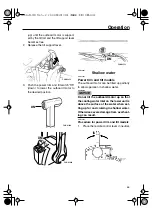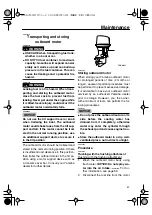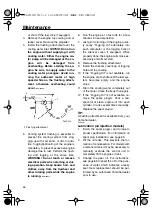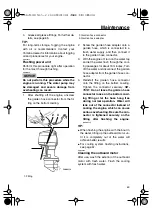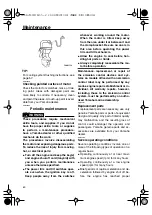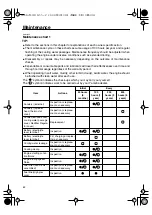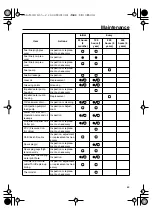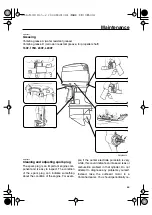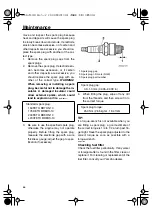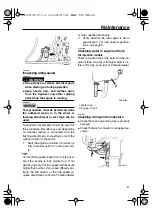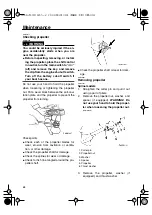
Maintenance
60
TIP:
For cooling system flushing instructions, see
page 57.
EMU28460
Checking painted surface of motor
Check the motor for scratches, nicks, or flak-
ing paint. Areas with damaged paint are
more likely to corrode. If necessary, clean
and paint the areas. A touch-up paint is avail-
able from your Yamaha dealer.
EMU2850A
Periodic maintenance
WARNING
EWM01871
These procedures require mechanical
skills, tools, and supplies. If you do not
have the proper skills, tools, or supplies
to perform a maintenance procedure,
have a Yamaha dealer or other qualified
mechanic do the work.
The procedures involve disassembling
the motor and exposing dangerous parts.
To reduce the risk of injury from moving,
hot, or electrical parts:
●
Turn off the engine and keep the key(s)
and engine shut-off cord (lanyard) with
you when you perform maintenance
unless otherwise specified.
●
The power trim and tilt switches oper-
ate even when the ignition key is off.
Keep people away from the switches
whenever working around the motor.
When the motor is tilted, keep away
from the area under it or between it and
the clamp bracket. Be sure no one is in
this area before operating the power
trim and tilt mechanism.
●
Allow the engine to cool before han-
dling hot parts or fluids.
●
Always completely reassemble the mo-
tor before operation.
Maintenance, replacement, or repair of
the emission control devices and sys-
tems on models affixed with an emission
control label may be performed by any
marine engine repair establishment or in-
dividual. All warranty repairs, however,
including those to the emission control
system, must be performed by an autho-
rized Yamaha marine dealership.
EMU28511
Replacement parts
If replacement parts are necessary, use only
genuine Yamaha parts or parts of equivalent
design and quality. Any part of inferior quality
may malfunction, and the resulting loss of
control could endanger the operator and
passengers. Yamaha genuine parts and ac-
cessories are available from your Yamaha
dealer.
EMU34150
Severe operating conditions
Severe operating conditions involve one or
more of the following types of operation on a
regular basis:
●
Operating continuously at or near maxi-
mum engine speed (rpm) for many hours
●
Operating continuously at a low engine
speed (rpm) for many hours
●
Brief periods of rapid acceleration and de-
celeration followed by engine shut off be-
fore the engine has reached proper
ZMU02550










